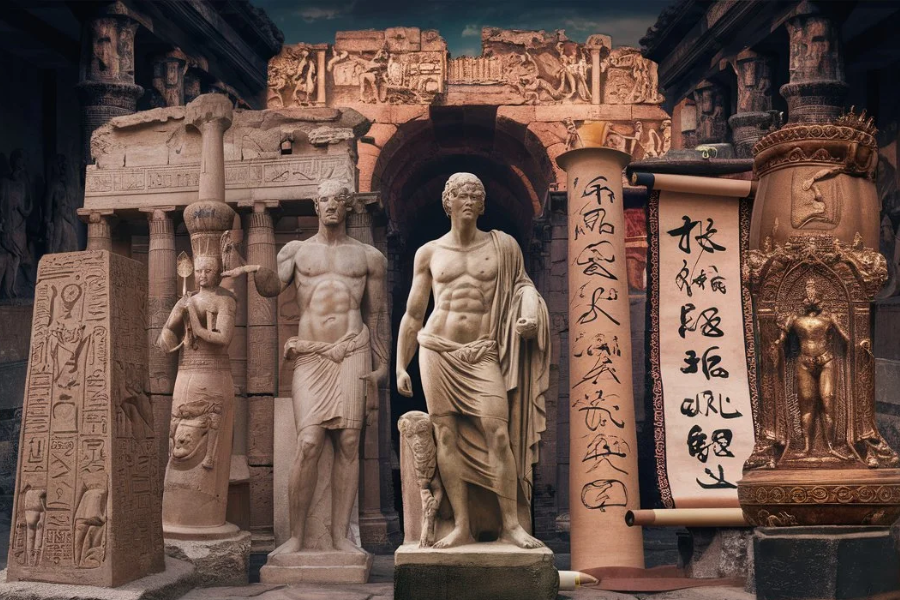Art has always been a cornerstone of human culture, reflecting our creative spirit and technical prowess throughout history. Ancient art, in particular, offers a captivating glimpse into the early expressions of human societies, revealing both their ingenuity and spiritual beliefs. This exploration delves into the origins of ancient art and examines the distinct influences from various regions around the world. Through different civilizations, these artistic traditions have left a lasting legacy that endures to this day.
Introduction to Ancient Artz
Ancient artz encompasses a broad range of works created by various prehistoric cultures worldwide over thousands of years. From the early cave paintings to the elaborate sculptures of ancient Greece and Rome, these artifacts offer a unique window into our ancestors’ lives, beliefs, and environments. They not only showcase the creativity of their creators but also highlight the significant evolution in human spirituality, technology, and social structures over time.
What is Ancient Art?
The term “ancient art” generally encompasses a wide range of cultures and time periods, beginning with prehistoric civilizations and extending through the Egyptian, Mesopotamian, Greek, and Roman eras, as well as notable cultures from regions like India, China, and Mesoamerica. This category includes diverse forms of artistic expression, such as paintings, sculptures, ceramics, and architecture. These artifacts serve as unique fingerprints of their respective cultures, offering valuable insights into their historical and cultural contexts.
The Origins of Ancient Artz
The exploration of ancient art begins with some of the earliest known human creations, providing valuable insights into the cognitive and cultural evolution of early societies.
Prehistoric Art
From cave paintings to ancient sculptures, prehistoric art represents some of humanity’s earliest and most fundamental forms of expression. Though simple and straightforward, these artworks provide crucial insights into the lives and creativity of early humans.
Cave Paintings
Some of the most remarkable and well-known pieces of prehistoric art ever discovered can be found in the France’s Lascaux Caves, which were discovered in 1940. Dating back approximately 17,000 years, these vibrant paintings depict animals such as horses, stags, and bison. The artwork is notable for its vivid colors and lifelike representation of animal behavior.
Venus Figurines
An example of early prehistoric art is the Venus of Willendorf, found in Austria and dating back to around 28,000-25,000 BCE. While the exact purpose of these small statues remains unclear, they are often linked to fertility symbols or ideals of female beauty. These figures are notable for their focus on the female form and represent some of the earliest instances of symbolic reasoning in human art.
Evolution of Ancient Artz
As human societies transitioned from nomadic lifestyles to settled agricultural communities, art also evolved in both purpose and complexity.
Neolithic Art
With the advent of agriculture, farmers were able to create more enduring works of art. This shift allowed for the preservation of art over time. Neolithic art, including intricate pottery and carved sculptures, such as the murals at Çatalhöyük in Turkey, provides valuable insights into early urban life and religious practices.
Key Characteristics of Ancient Artz
Functionality: Much of ancient art served practical purposes. For example, Egyptian art was closely linked to religious rituals and beliefs about the afterlife, while Greek art often celebrated gods and athletic achievements.
Symbolism and Ritual: Ancient art frequently used symbolism to express complex ideas, deities, or myths. Rituals and religious beliefs heavily influenced its themes and motifs.
Materials and Techniques: Artists in ancient times used materials available in their regions, such as clay, stone, bronze, and natural pigments. Techniques varied widely, including fresco painting, marble sculpting, and the crafting of intricate jewelry.
Historical Context: The social, political, and economic circumstances of its time are reflected in ancient art. Roman art, for instance, often depicted political figures and military achievements, while the art of the Indus Valley civilization is recognized for its sophistication and portrayal of daily life.
Cultural Influence: Ancient art was not created in isolation but often shows cross-cultural interactions. For example, Mediterranean art displays influences among Greek, Roman, and Egyptian styles.
Early Societies’ Use of Ancient Art
In early societies, art played a crucial role, serving both functional and symbolic purposes. It was deeply connected to religion and spirituality, with temples, shrines, and sacred objects often featuring intricate designs that reflected the era’s religious beliefs and practices. For instance, ancient Egyptians used art to honor their gods and pharaohs, with elaborate tomb paintings and statues illustrating scenes from the afterlife.
Beyond its religious significance, art also functioned as a means of communication. Before written language became widespread, art was essential for conveying stories, laws, and cultural traditions. The ancient cave paintings at Lascaux in France exemplify how early humans used art to document their experiences, including hunting scenes and aspects of daily life.
The Role of Art in the Afterlife
One of the most intriguing aspects of Egyptian art is its connection to the afterlife. Much of this art was created specifically for tombs and temples to aid the deceased in their journey to the next world. Tomb walls were often decorated with detailed scenes of the deceased making offerings to the gods, hunting, or participating in activities meant to ensure a safe passage to the afterlife.
A prime example is the tomb of Tutankhamun, discovered in 1922 by archaeologist Howard Carter. The tomb was filled with artistic treasures, including the famous golden death mask of the young pharaoh. Each item was meticulously crafted to serve a purpose in the afterlife, illustrating the Egyptians’ belief that art had the power to transcend the physical realm and support the soul on its eternal journey.
The Techniques and Materials of Ancient Artz
The creation of ancient art demanded a profound understanding of materials and techniques. Early artists utilized locally available resources such as stone, clay, wood, and metal. Techniques were handed down through generations, with each culture developing unique methods to achieve their artistic goals.
For instance, the Egyptians excelled in stone carving, producing intricate statues and reliefs that have endured for millennia. The ancient Greeks, on the other hand, mastered bronze casting, enabling them to create highly detailed and dynamic sculptures. Meanwhile, Mesoamerican cultures were renowned for their craftsmanship with jade, obsidian, and other precious materials, using these to create elaborate jewelry, ceremonial objects, and masks.
The Impact of Ancient Art on Contemporary Art
The influence of ancient art is still evident in modern art and design. Contemporary artists often draw inspiration from the styles, themes, and techniques of ancient civilizations, blending these elements into their own creations. The enduring appeal of ancient art lies in its ability to cross cultural and temporal boundaries, offering a universal mode of expression.
For example, architectural elements such as columns, domes, and arches can be traced back to ancient Greek and Roman designs. Similarly, the motifs and patterns found in ancient textiles and pottery continue to inspire fashion designers and artisans around the world. Studying ancient art also provides valuable insights into the evolution of artistic techniques and materials, shaping how modern artists approach their work.
The Impact of Ancient Artz
Classical art has had a profound and lasting impact on both artwork and cultural traditions, influencing various aspects of high culture. Its influence extends into many facets of everyday life, shaping aesthetics and cultural norms.
Influence on Modern Art
In our contemporary work, we incorporate elements from a wide range of cultures, often with a depth of understanding greater than that achieved by Greek poets or medieval painters. Thanks to advances in knowledge and communication, we have unprecedented access to and awareness of these diverse cultural influences, for better or worse.
Cultural Preservation of Ancient Artz
Art provides a window into the past, allowing us to reflect on our history and understand what has shaped our present. Ancient art, in particular, tells the stories of long-gone civilizations, revealing their cultural practices and beliefs.
Educational Value on Ancient Artz
Exploring ancient visual culture offers valuable insights into the development of artistic techniques and cultural values across different eras and regions.
Conclusion
Ancient art serves as a remarkable testament to the creativity, beliefs, and technological advancements of early civilizations. From the rudimentary cave paintings of prehistoric times to the sophisticated sculptures of ancient Greece and Rome, these artistic expressions offer an invaluable glimpse into the lives and cultures of our ancestors. As humanity transitioned from nomadic lifestyles to settled societies, art evolved in complexity and purpose, reflecting changes in spirituality, social structures, and daily life.
The enduring legacy of ancient art is evident in its influence on modern artistic practices and cultural traditions. We gain a deeper appreciation for the artistic achievements of previous civilizations and their influence on contemporary culture by studying these ancient artifacts. Ancient art not only enriches our understanding of history but also continues to inspire and shape the world of art and design today.
FAQs
1. What is “ancient artz”?
“Ancient artz” refers to the artistic works created by various civilizations from prehistoric times through the Egyptian, Mesopotamian, Greek, and Roman eras, as well as notable cultures from other regions like India, China, and Mesoamerica. This term encompasses a diverse range of artistic expressions, including paintings, sculptures, ceramics, and architecture.
2. Why is ancient art important?
Ancient art provides crucial insights into the lives, beliefs, and environments of early human societies. It reveals the evolution of human creativity, spirituality, and social structures, offering a window into the past and influencing modern art and design.
3. What notable works of prehistoric art are there?
Notable examples of prehistoric art include the cave paintings in the Lascaux Caves in France, which date back around 17,000 years, and the Venus figurines such as the Venus of Willendorf, found in Austria and dating to around 28,000-25,000 BCE. These artifacts highlight early human creativity and symbolic reasoning.
4. How did art evolve from prehistoric times to later civilizations?
As societies transitioned from nomadic lifestyles to settled agricultural communities, art became more complex and enduring. Neolithic art saw the creation of intricate pottery and sculptures, while later civilizations like the Egyptians, Greeks, and Romans developed advanced techniques and materials to produce detailed and symbolic works of art.
5. How has ancient art influenced modern art?
Ancient art continues to inspire modern artists through its styles, themes, and techniques. Architectural elements such as columns and arches, as well as motifs found in ancient textiles and pottery, influence contemporary design and fashion. The study of ancient art also helps modern artists understand the evolution of artistic techniques and materials.
6. What role did art play in early societies?
Art was used for both practical and symbolic purposes in early societies.. It was deeply connected to religion and spirituality, with many artworks designed for temples, tombs, and rituals. Art also acted as a means of communication before the widespread use of written language, documenting stories, laws, and cultural traditions.
7. How can we benefit from studying ancient art today?
Studying ancient art helps us understand the development of artistic techniques, cultural values, and historical contexts. It allows us to reflect on our history, appreciate the achievements of past civilizations, and gain insights into how these ancient practices continue to shape modern art and cultural traditions.
Keep up-to-date with breaking news and updates on letmagazine



